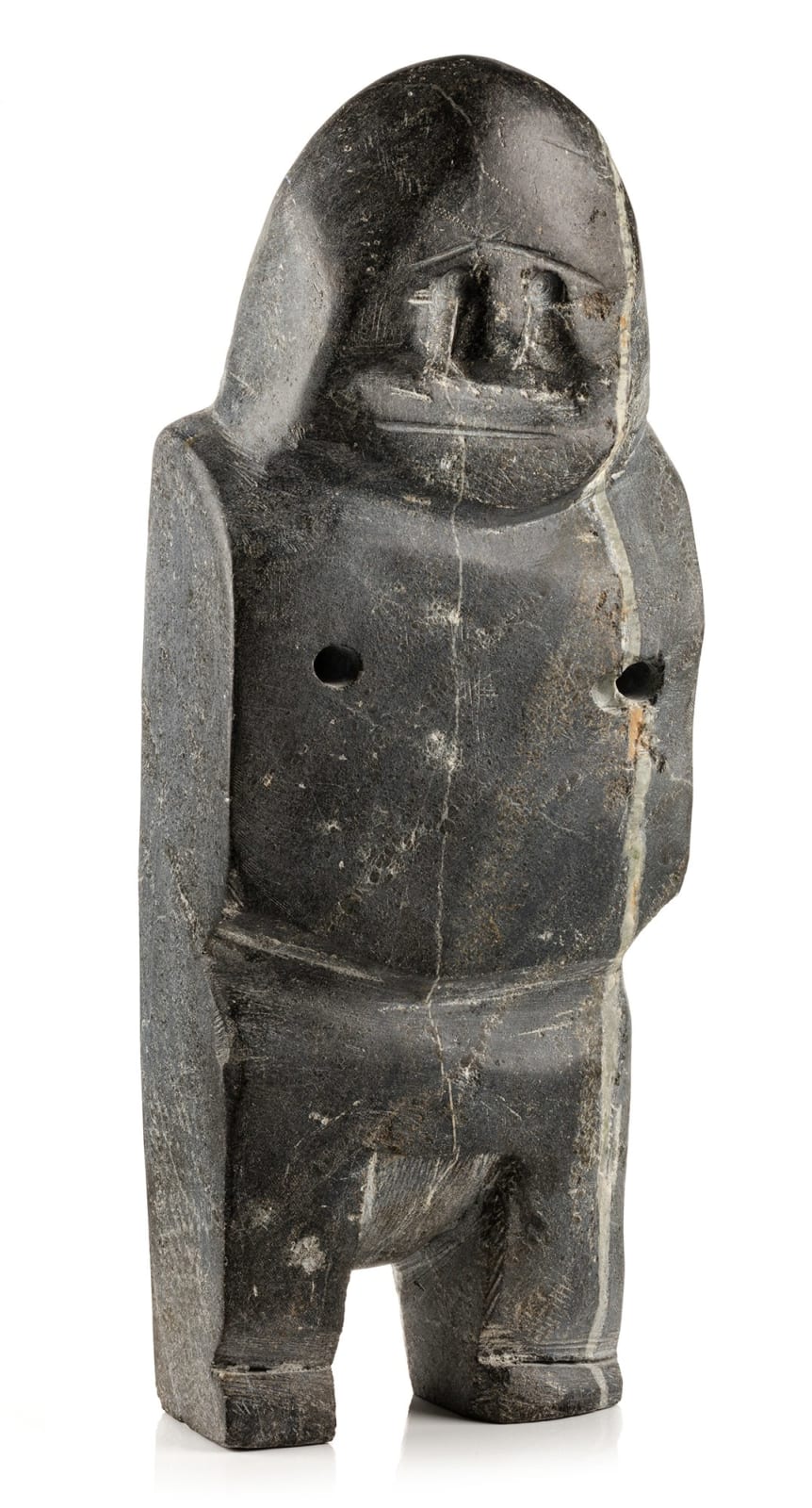JOHN KAVIK (1897-1993) KANGIQLINIQ (RANKIN INLET)
unsigned.
ESTIMATE: $12,000 — $18,000
PRICE REALIZED: $10,980.00
Further images
Born near Gjoa Haven in 1897, John Kavik lived for decades in his native Utkuhiksalingmiut territory, inland between Baker Lake and Cambridge Bay. Starvation forced him to relocate south in the late 1950s, first to Baker Lake where he reunited with his childhood friend Luke Anguhadluq. Kavik then moved to Rankin Inlet in 1958, but already over sixty years old, was unfit to work at the nickel mine there. Determined to make a living, he began carving in 1960 and kept at it until he was about ninety! The anthropologist Robert Williamson lived in Rankin Inlet from 1960 to 1973 and met Kavik at the very beginning of his art career. He described Kavik as an appealing humourist, full of fun, an artist who carved with joy, and a man of great kindness. [1] These comments might come as a surprise to those who perceive his art as stark and bleak. Stanley Zazelenchuk, Kavik’s neighbour in the 1970s, wrote in 1980 of his friend’s sense of humour, work ethic, and his independence from southern market demands. [2] Kavik was in his eighties by then and still going strong.
We recall describing our amazement that Kavik, age about eighty-three, could even have lifted the piece of stone used for a sculpture (First Arts, 30 November 2021, Lot 40). Well, Kavik was probably a couple of years older when he carved this colossus, one of his largest sculptures ever. Stylistically, it resembles a group of works, many small but some quite large, that he carved in the early to mid 1980s. This extraordinary late effort resulted in a solo exhibition at the Inuit Gallery of Vancouver in 1990. [3]
Standing Man was not in the exhibition but would certainly have been one of the stars of the show. Unlike the great majority of Kavik’s sculptures, it is evidently carved from a rectangular block of hard, quarried stone, with some straight edges left intact. Working this piece would have entailed a heroic effort, further complicated by an even harder, quartz-like white vein running down its length. The result is nothing short of awesome. Kavik removed a relatively small amount of material; it could be argued that this is one of his more minimalist creations. But the visual, psychological, and sheer physical impact of the sculpture is enormous. Once again, we are gobsmacked.
We wonder if this isn’t a self-portrait (perhaps many of Kavik’s sculptures are). In which case, a fitting title might be I’m Still Standing. (Apologies to Elton and Bernie)
1. Gleaned from his article, “Creativity in Kangirlliniq” in Bernadette Driscoll, Rankin Inlet / Kangirlliniq, (Winnipeg: Winnipeg Art Gallery, 1981), pp. 11-23.
2. Stanley Zazelenchuk, “Kavik: The Man and the Artist” in Arts & Culture of the North, (Vol. IV, No. 2 Spring 1980, 219-221).
3. Inuit Gallery of Vancouver, John Kavik, June 16 – July 7, 1990 (illustrated catalogue with 45 works).
References: For the section on John Kavik in Norman Zepp, Pure Vision: The Keewatin Spirit, (Regina: Norman Mackenzie Art Gallery, 1986), see pages 108-119. For an appreciation of the artist and his work see Stanley Zazelenchuk, “Kavik: The Man and the Artist” in Arts & Culture of the North, (Vol. IV, No. 2 Spring 1980), pp. 219-221. Masterpieces by Kavik are widely published; see George Swinton, Sculpture of the Inuit, (Toronto: McClelland & Stewart, 1972/92); Canadian Eskimo Arts Council, Sculpture/Inuit (Toronto: University of Toronto Press, 1971); Ingo Hessel, Inuit Art: An Introduction, (Vancouver: Douglas & McIntyre / New York: Harry Abrams / London: British Museum Press, 1998); Gerald McMaster, ed., Inuit Modern: The Samuel and Esther Sarick Collection, (Toronto: Art Gallery of Ontario, 2010); and many more books and exhibition catalogues.
Provenance
Private Collection, NY, USA;
Waddington's, Toronto, 17 Nov 2014, Lot 153, as "Contemplative Man, c. 1975., and "Prominent private collection, NY, USA;"
Acquired from the above by Robert Noakes, Toronto;
Estate of the above.
Noakes was a renowned Canadian interior designer and owner of RNI Robert Noakes International.
Join our mailing list
* denotes required fields
We will process the personal data you have supplied in accordance with our privacy policy (available on request). You can unsubscribe or change your preferences at any time by clicking the link in our emails.










